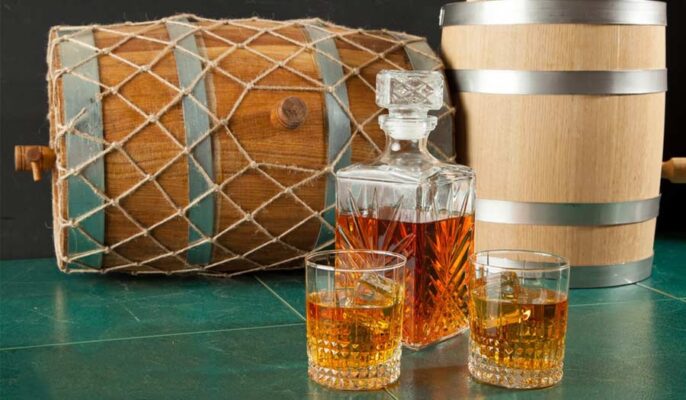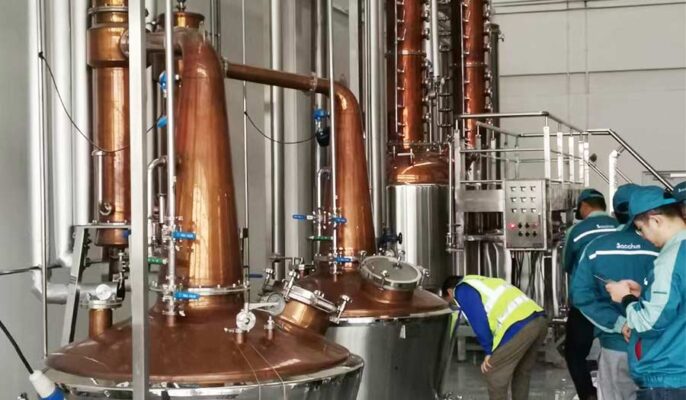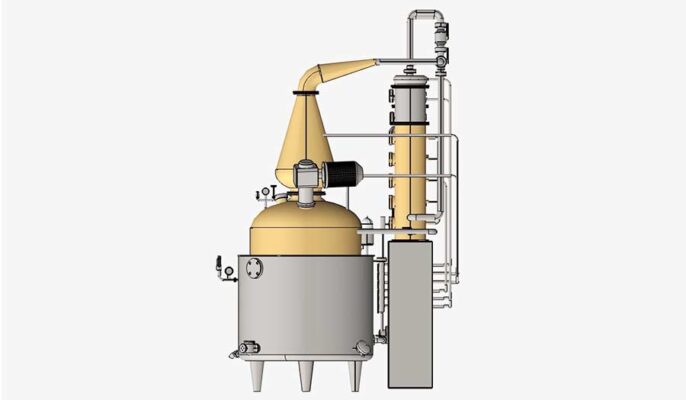美味しいワインを造りたいなら、適切なワイン造りが不可欠だ。 蒸留装置.ワイン製造業界の初心者であろうと熟練者であろうと、適切な蒸留装置を持つことで、製品の可能性を最大限に引き出すことができる。蒸留は、もろみやワインなどの液体アルコールを蒸留器で加熱し、発酵させることから始まります。液体が加熱されると、アルコールが蒸発して蒸留器の上部に上昇し、そこでアルコールが回収され、高濃度の溶液に濃縮されます。この記事では、ワイン醸造のための蒸留装置の使い方について、装置の選び方などの内容も含めて詳しくご紹介します。
蒸留ワインとは何か?
蒸留ワインとは、アルコール度数を高めるために加工されたワインのことである。ワインのアルコールは発酵によって生成される。ワイン用ブドウを破砕して果汁を取り出し、ワインメーカーはこれをマスト(果汁)と呼ぶ。ブドウ果汁には糖分が含まれており、酵母を加えるとアルコールに変化する。
アルコール度数が高すぎると酵母が生存できなくなるため、当然、発酵ワインの濃度は制限される。そのため、アルコール度数が16%を超える普通のワインを見つけることはできない。アルコール度数の高い飲料を作るには、ワインを蒸留しなければならない。

の基本原則 蒸留装置
蒸留とは、液体混合物中の異なる成分を、各成分の異なる沸点に基づいて分離するプロセスです。蒸留装置は、液体を加熱して蒸気にし、凝縮させて液体にすることで、アルコールとその他の成分を分離します。一般的な蒸留装置には、蒸留器(一般的な銅製蒸留器など)、塔型蒸留装置、還流蒸留装置などがある。
- 加熱ポット:発酵液を加熱し、蒸発を促進させる。
- 蒸気発生器:加熱によって発生した蒸気を凝縮装置に導く。
- 復水器:冷却水または空冷システムを使って蒸気を液体に冷却する。
- 受け容器:蒸留液を回収するために使用する。
蒸留と醸造プロセス
- 原料の選択:対象となるアルコールの種類に応じて、穀物(大麦、トウモロコシ、ライ麦)、果実(ブドウ、リンゴ)、糖蜜など、適切な原料が選択される。
- 発酵させる:原料を水と混ぜて発酵液を作る。発酵液に酵母を加え、酵母が糖分をアルコールと炭酸ガスに変える。酵母の種類によって、発酵プロセスや最終的な風味に与える影響が異なる。
- 蒸留:発酵した液体を蒸留釜に注ぎ、加熱してアルコールなどの揮発成分を蒸発させる。蒸発したアルコール蒸気をコンデンサーで冷却し、液体に再凝縮したものが蒸留液である。
- 熟成:特定の温度と湿度の条件下で、アルコール液が容器の素材(オークなど)と化学反応を起こし、複雑な風味とアロマを生み出す。
- ブレンドとろ過:異なるロットの蒸留酒は、風味の一貫性を確保するためにブレンドされる。残留する固形物や不純物は、アルコールの純度と味を向上させるために濾過によって取り除かれる。
- 包装:最終製品は瓶詰めされ、ラベルが貼られ、密封され、販売準備が整う。包装前に品質検査を行い、規格に適合していることを確認する。
蒸留プロセスの種類
- 分別蒸留:このプロセスでは、同じ液体を複数回蒸留する。蒸留は、混合物から異なる物質を除去するために、温度を上げながら複数回行われる。
- 水蒸気蒸留:蒸留は、温度に敏感な化合物からすべての元素を抽出するために行われる。このプロセスを実施するには、液体をさまざまな沸騰温度にさらす必要がある。
- 減圧蒸留:液体中に存在する物質の中には沸点が非常に高いものがある。この場合、塔圧を下げる方が効率的である。こうすることで、混合物中の蒸気圧の低い元素がより蒸発しやすくなる。
醸造工程に必要な蒸留設備
- 麦汁樽:麦芽を温度調節された水と混ぜ合わせ、マッシングによってデンプンを発酵可能な糖分に変え、麦汁の発酵プロセスを開始する容器。容器には底があり、使用済みの穀物を液体から分離し、発酵に適した麦汁を製造するためのふるいが付いている。
- 発酵タンク:発酵タンクは糖分をアルコールに変換する鍵となるもので、酵母を加えた麦汁を貯蔵するために使用される。数日間にも及ぶ発酵プロセスでは温度管理が不可欠。発酵タンクには、発酵中に発生するガスを連続的に逃がすための圧力開放弁が装備されている。
- ポンプ小規模な醸造所は手動で管理できますが、大規模な醸造所では、液体を安全かつ効率的に移動させるためにポンプに依存しています。典型的なセットアップには、操作を簡素化するために、麦汁ポンプと高濃度ポンプが含まれる場合がある。
- ポットスチル:ポットスチルは大きな釜に似ており、テキーラやシングルモルトウイスキーのような風味の強い蒸留酒の製造に適している。洗浄と再充填のために定期的な休止時間が必要で、効率は限られるが、独特の風味が得られる。
- コラムスチル:連続蒸留が可能な円柱と垂直のプレートからなる蒸留器で、ウォッカ、ラム、ジンなどの軽い蒸留酒に適している。ポットスチルのような風味はないが、効率的である。
- コンデンサー:蒸発したアルコールを冷却して凝縮させるコイルで、凝縮器は濃縮されたアルコールを回収するのに役立つ。多くの場合、製品をさらに蒸留して濃縮する。
- ろ過装置:バッグフィルター、フィルターカートリッジ、フィルターペーパーなどの様々なオプションは、微粒子を除去し、貯蔵前のアルコールを透明化し、品質と外観を向上させるのに役立つ。
- 貯蔵・熟成容器ステンレスタンクやオーク樽は、蒸留酒を貯蔵するための一般的な選択肢であり、瓶詰め前に熟成させ、風味を向上させる。
- 清潔で安全な設備蒸留所の操業において、清潔さの維持と安全性の確保は最優先事項である。製品の品質と作業員の健康を守るためには、十分な衛生管理と安全対策の設備が不可欠である。

蒸留器の選び方
種類 蒸留装置
商業用アルコール蒸留装置には多くの種類があり、それぞれ蒸留プロセスにおいて異なる目的を果たす。ポットスチル、カラムスチル、ハイブリッドスチルである。ポットスチルは伝統的で手作りの職人技で知られ、小ロットに適している。一方、カラムスチルは連続的に蒸留を行うため、大量生産に向いている。ハイブリッド・スチルはこの2つのバランスをとり、ポットスチルとコラムスチルの要素を組み合わせて汎用性を高めている。
容量とサイズ
蒸留装置の適切なサイズと容量を決定することは、生産を最適化するために不可欠です。決断を下す前に、生産目標、予想される需要、利用可能なスペースを考慮してください。生産ニーズを満たし、過不足のない設備に投資することは、費用対効果を高めるために不可欠です。
素材の品質と構造
業務用蒸留器で使用される素材の品質は、その性能と寿命に大きな影響を与えます。ステンレススチールは耐久性、耐腐食性、洗浄のしやすさから一般的な選択です。高級な銅製の部品は、ウイスキーのような特定の蒸留酒の風味を高めることもできます。
加熱方法と温度制御
目的のアルコール度数と風味を得るためには、効率的で正確な加熱が不可欠である。加熱方法は、直火加熱、蒸気加熱、電気加熱など様々である。それぞれの方法には利点があり、最終的なスピリッツの特性に影響を与える。さらに、蒸留の過程で一貫性を保つためには、複雑な温度制御機構が不可欠である。
安全性とコンプライアンス
アルコールの蒸留には潜在的に危険な工程が含まれるため、安全性が最優先されます。業務用蒸留装置を購入する際には、それが安全基準と規制に適合していることを確認してください。地域や国際的な規制を遵守することは、法的な問題を回避し、オペレーターや消費者の幸福を確保するために不可欠です。

よくあるご質問
原料はどのように準備するのか?
適切な原料(穀物、果物、糖蜜など)を選び、必要な加工を行う。例えば、穀物を粉砕して糖化したり、果実を圧搾してジュースにしたりする。原料が清潔で、ワイン醸造に必要な条件を満たしていることを確認する。
蒸留装置はどのようにセットするのですか?
発酵した液体をスチルに注ぎ、加熱してアルコールを蒸発させる。蒸気を冷却し、コンデンサーで液体に変える。蒸留がスムーズに進むよう、適切な加熱温度と凝縮条件を設定する。
蒸留中の泡の処理方法は?
泡があふれて蒸留効果に影響を与えないように、泡防止剤を加えるか、泡ブレーカーを使用する。スチルの液面が適切であることを確認し、過剰な泡の発生を避ける。
蒸留効率を確保するには?
分留塔、コンデンサー、その他の部品の状態を定期的にチェックし、清潔で良好な作動状態を保つ。分留塔の還流比と加熱パラメーターを調整し、分離効果を最適化する。
器具の洗浄とメンテナンスの方法は?
機器メーカーの清掃とメンテナンスのガイドラインに従い、スチル、コンデンサー、その他の主要部品を定期的に清掃する。機器の機能を定期的にチェックし、すべての部品が正常に機能していることを確認する。




